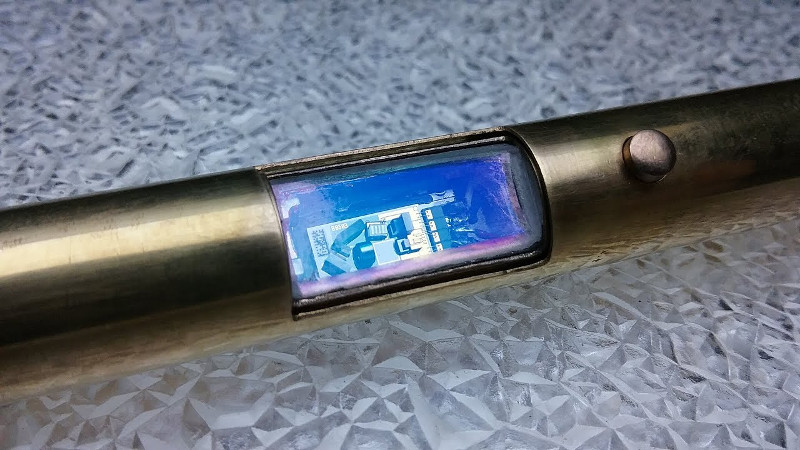As a society, we’ve largely come together to agree that laser pointers are mostly useless. They’re now the preserve of university lecturers and those destined to wind up in a jail cell for harassing helicopter pilots. Most pointers are of the diode-pumped solid state variety. However, [Zenodilodon] treads a different path.

Instead of the usual DPSS build, this pointer packs an optically pumped semiconductor laser, or OPSL. These lasers have the benefit of a wider selection of output wavelengths, and can be built to offer less variance in beam parameters such as divergence.
The build is an attractive one, with the pointer chassis being manufactured out of brass, with several components plated in yellow and rose gold. There’s even a sliding window to observe the laser cavity, which glows brightly in operation. [Zenodilodon] goes into great detail during the machining process, showing all the steps required to produce a visually appealing device.
It’s certainly one of the prettiest laser builds we’ve seen, and it’s always nice to see makers exploring different technologies. Similarly to our recently featured 1.4 W laser pointer, it’s largely a packaging operation, but if you’re building your own laser diodes at home – you know where to send ’em. Video after the break.

















“As a society, we’ve largely come together to agree that laser pointers are mostly useless.”
One word: Cats.
Cats are very useful.
MMMM Tacos!
TACOCAT spelled backwards is TACOCAT.
Yep, but you are pretty usefull for cats, as a slave.
So many cats…so few recipes.
They say you can easily adapt hare recipes for them.
Mmmm. Hare in chocolate sauce.
“They’re now the preserve of university lecturers ”
I find most prefer to use the mouse cursor, because it’s more visible.
And they don’t get lynched by students with horrible headaches.
Where do you get the OPSL and how much does it cost?
It is an Osram PL530. You can sometimes find it surplus on ebay for between 20 and 50$. Output power is around 60mW. It is soften used for holography applications.
It’s not an OPSL. It’s a PPLN doubled 1060nm laser diode.
There is an OPS chip that converts 808nm into 1060nm, Where you are correct part of it is a doubled 1060nm to 530nm. An OPSL laser often uses one pump in IR of X and shift it into a deeper IR before resonating. This ability to see the OPS chips output characteristics is what makes them capable of so many colors in general.
Yes, there is such a device. This is not that.
Brain, I grant you I might be missing something, but a PPLN laser does not have an OPS chip in it at all. It’s much more like a DPSS laser in constriction being made in a linear optical pathway assembly in a mount or in a resonator cavity. Some have other parts in there as well. It has yes PPLN characteristics as far as doubling crystal composition for frequency doubling. Another thing to note is much like a DPSS the green formed from a PPLN laser is usually the same 532nm, not 530nm. I will say I cannot find direct mention of the module being either PPLN or OPSL but the construction and forums lend me to think it’s design merits the term OPSL over PPLN in both assembly and parts in which are contained. If you can find a direct datasheet with confirmation I would love to see it or if you have an advanced understanding in optics that may be greater than my own please let me know where my misunderstanding is. I even have that listed in the video description that I am not 100% certain of everything involved.
PS: This is the datasheet: http://optoengine.com/images/Documents/OEMLasers/PL530.pdf
PS: This is the datasheet: http://optoengine.com/images/Documents/OEMLasers/PL530.pdf
Sorry if I post this two times, it seems my previous comment disappeared.
That’s not an OPSL. That’s a doubled (second harmonic) 1060nm laser diode.
Long distance Morse code.
Ostracus -CAN’T FIGURE OUT WHAT YOU ARE RESPONDING TO. But what do you think about a a standard LASER pointer driven by a PSK31 audio signal for text? Or for that matter a FREEDV signal for voice.
Certainly demonstrates that laser pointers aren’t “mostly useless”.
Still just a DPSS laser.
I miss-spoke in the start, DPSS is very similar to how this works yes, I was so used to saying DPSS >.< The biggest difference is that there is an OPS chip taking the role of part of the transformation and not a gain medium crystal like ND:YAG or ND:YV04.
Now thats a cool laser!
“… laser pointers are mostly useless.”
Astronomy parties come to mind.